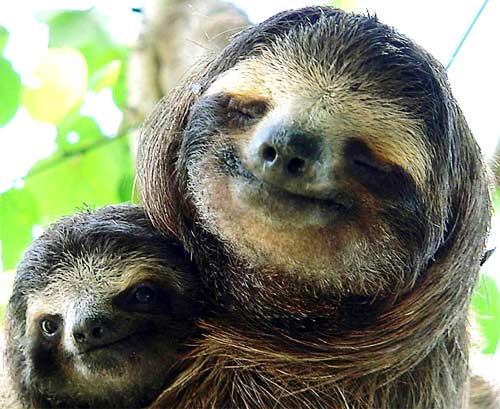
In some species the male may stay for a day or two and there may be several matings, but in other species the male departs right after a single 6 second act of intercourse. In fact, the whole experience from first contact to completion of deed may only be a matter of seconds. Then, once a gentleman makes his way up to her, it is basically first come first served without any posturing or foreplay. She generally does not leave her own trees and just waits for a suitor to arrive. Normally demure, a lady sloth in heat screams continually until a male finds her or her season passes. Sloth females come into heat about once a year and they let the whole neighborhood know it. It takes about a month to digest a leaf, about a minute to move 15 feet and about 6 hours to make it to the bathroom and back.īut there is one thing that sloths do with amazing speed, and that one thing is sex. So we know that the sloth is incredibly slow. All of its internal organs, including the heart, liver, spleen and stomach, are rearranged inside its body cavity so nothing gets crushed or obstructed.Įven the fur on the sloths torso and limbs grows in the opposite direction than it would in other animals with the follicles pointing up the arms and away from the belly so the hairs guide rain water and debris to the ground.Īs an example of the effortlessness with which sloths dangle from the highest limbs, it is not uncommon for a sloth to pass away and remain securely hooked to its final branch. The entire sloth is designed for a life of inversion. A sloth spends approximately 85% of its life hanging completely upside down, mainly because it requires no effort.
/bradypus-tridactylus-143410629-57fff75f5f9b5805c2b3e14c.jpg)
It is the construction of the claws and limbs, and a natural retraction of the ligaments that creates the "gripping reflex" of the sloth. Muscle power is not required for the sloth to grip branches, in fact sloths have about 30% less muscle mass than other mammals of equal size. The claws on all four limbs curve in toward the wrist creating four large, natural hooks.

The claws on the front feet are about 4 inches long, and can be used as a weapon when the sloth is cornered.

There is a suggestion that all sloths are three-toed because the front "toes" are actually "fingers". Three toed sloths rear legs, feet and claws are shorter than the front and both two-toed and three-toed sloths have three toes on the rear legs. Sloths do not build nests, instead they find a leafy area and simply fall asleep hanging completely upside down with all four limbs grasping a branch. Sloth FactsĪll of the sloth species have numerous amazing adaptions, not only for an arboreal life high in the trees, but also for a life lived in an inverted position. With so much effort exerted to extract a minimum of nutrients, the sloths metabolism is amazingly slow- the slowest in the entire animal kingdom.

The process takes so long that a leaf consumed in August might not be eliminated until October. Within the sloths belly is a sea of micro bacteria that help to breakdown and eventually digest what they eat. The lack of grooming leads the sloths dense coat to actually grow algae during the rainy season, giving them a greenish tinge. They end up spending almost every waking moment quietly munching on leaves with little time for grooming or any other activities. Sloths exist on a diet almost entirely of leaves, which is such an inferior source of nutrition and energy that it shapes their whole lifestyle. Sloths come in two and three toed varieties and are related to anteaters, who have similarly formed long arching toenails. With the help of extremely specialized claws, sloths eat, sleep, breed and give birth all while dangling from the tallest branches of cecropia trees. The sloth is almost entirely arboreal, spending over 95 percent of its existence high up in the trees of Central and South America.


 0 kommentar(er)
0 kommentar(er)
